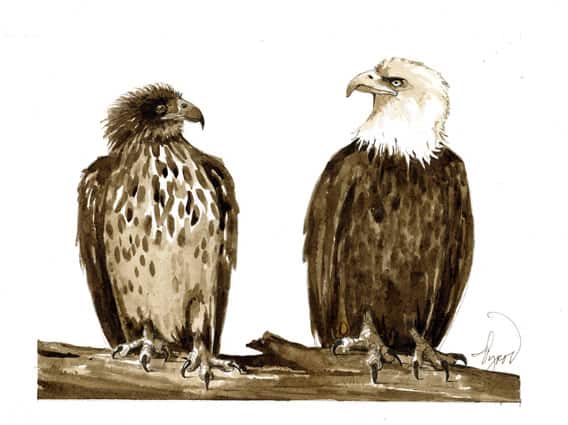By Elise Tillinghast
A deer died by the river near my home. The crows found it, as did other scavengers–a bald eagle and two big brown raptors that were hard to identify. Both had white flecking on their heads, wings and bodies, but the markings didn’t match up, bird to bird. They looked unkempt and more than a little disreputable.
It turns out these were also bald eagles, but young birds, dressed in dark plumage. In common with some other long-lived species, eagles have an extended adolescence. They require about four to five years to mature. During this period they don’t find mates, establish territories, or conform to the adult dress code.
“They can really look a mess,” said Chris Martin, a senior raptor biologist at New Hampshire Audubon. At the time an eagle fledges, its primary and secondary wing feathers–the big feathers along the back edge of the wing–are longer than they’ll ever be again. This extra length makes the wing area greater and likely provides more lift for rookie flyers, although it lessens aerial grace.
As the fledgling wing feathers molt, beginning when the eagle is around nine months old, they grow back at the slightly shorter, adult length. The result is a jagged appearance that persists for about two years, until all of the original set of primary and secondary feathers have been replaced. (Eye and beak color also change during adolescence; they start off dark and slowly transition to yellow.)
Although immature plumage is mostly brown, it’s highly variable among individuals, which explains my birds’ haphazard white markings. According to Todd Katzner, a wildlife biologist at the U.S. Geological Survey, there’s some thought that this dark color has a signaling purpose. It may tell adult birds that youngsters aren’t fully mature and thus not a threat to a breeding territory. What is certain, he said, is that in nesting season, when mated eagles are intolerant of adult eagle intruders, they’re much more likely to let young birds linger nearby.
This tolerance is helpful, because unlike adults, immature eagles often travel hundreds of miles during nesting season, which begins in early spring and extends through summer. “They bounce around a lot,” said Martin.
So what are these youngsters doing, other than flying around and looking messy? “They’re experimenting,” Martin explained. “They’re learning how to make it in the world.” One of the ways they do this is by following mature eagles. From these elders, they learn where fish are concentrated, where to scavenge, what roosts offer the best thermal cover on cold nights.
They also play house. Katzner described how an immature eagle may join up with a bird of the opposite gender to practice building a nest. Often these nests will be “pretty shoddy,” he said, “but they learn to do better next time.”
Another critical aspect of a young eagle’s education is learning how to get along with other eagles. While all eagle species are social, said Katzner, bald eagles take it to an extreme. They roost and forage in groups, and this means that they also get into more conflicts. “They’re sort of like humans that way.”
At a food site, or when crossing another bird’s territory, an immature eagle has to figure out how to assert itself and how to back down from a fight. “Eagles do a lot of posturing, a lot of wing spreading and showing their talons,” explained Katzner. Learning this language is important to avoid getting wounded or even killed, and it can be a hard-won skill. “Some of them never learn,” said Martin.
They must also master the diplomatic art of circling. If you have ever noticed a pair of eagles performing what looks like a series of lazy rotations across the sky, what you may have witnessed was one eagle chasing the other away. Katzner calls this behavior “escorting a bird out of your territory,” and it’s a common way that mature eagles rid themselves of younger birds. If the escortee doesn’t understand the cue, or perhaps is a four-year-old bird that is feeling its hormones, then this circling can escalate into outright combat. (In some cases, fights result in interlocked talons and two giant raptors falling out of the sky. Yes, this really happens.)
All told, learning to be an eagle is hard work. So the next time you see a scruffy brown raptor lurking among the crows, go easy on the kid. Don’t mock his messy coiffure. He’s still growing up and has a lot on his mind.
Elise Tillinghast is publisher of Northern Woodlands Magazine, and executive director of the Center for Northern Woodlands Education, www.northernwoodlands.org. The illustration for this column was drawn by Adelaide Tyrol. The Outside Story is assigned and edited by Northern Woodlands magazine and sponsored by the Wellborn Ecology Fund of New Hampshire Charitable Foundation: [email protected].




